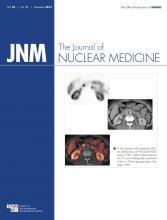REPLY: I would like to thank Drs. Freudenberg, Oehme, and Kotzerke for their insightful comments and for sharing their software tool for implementation of the dynamic bladder model.
I am uncertain why our urinary fraction (calculated as the fraction of total activity within an expanded volume of interest encompassing the bladder) with respect to the total activity within the torso (calculated as the total activity within an expanded volume of interest encompassing the torso) differs from Drs. Freudenberg, Oehme, and Kotzerke’s experience. Retrospectively, analyzing the first 20 patients of our dataset (as opposed to the initial 8 used for dosimetry) who underwent continuous 3-time-point serial imaging, the mean urinary fraction was 0.16 ± 0.04 with a range of 0.05–0.27. Our patients were requested to maintain good hydration for the 24 h before imaging, likely increasing the urine flow rate. This precaution should increase the urinary clearance rate but may not have a large effect on the urinary fraction (because of the rapid skeletal uptake).
Contrary to prior reports, the radiation dose for 18F-NaF PET is lower than that for 99mTc-methylene diphosphonate (MDP) or similar planar bone scans. By our calculations, using ICRP 103 weighting factors, the effective dose of a 740-MBq (20-mCi) 99mTc-MDP scan is 5.0 mSv (1) and that of a 185-MBq (5-mCi) 18F-NaF PET scan is 3.1 mSv (2). It is the addition of the whole-body (vertex to toes) low-dose CT transmission scan, which in our clinic is 4.5 mSv (whole-body Phillips Gemini PET/CT scanner using the ImPACT CT patient dosimetry calculator, version 0.99x 20/01/06, for an adult subject, a pitch of 1.438, 60 mAs, 120 kV, and collimation of 24) (3), that increases the radiation exposure. In our experience, in prostate cancer and multiple myeloma, the transmission CT increases reader confidence in interpretation as it better defines areas of degenerative disease. If 99mTc-MDP SPECT/CT were performed, the combined effective dose would be 9.5 mSv (as compared with 7.6 mSv for 18F-NaF PET/CT). The real question is whether the CT adds sufficient medical benefit to warrant the increased radiation exposure.
Thus, it is important that when we compare PET and conventional bone scans we appropriately consider the CT component. As we all strive to reduce the overall radiation exposure to our patients, we must continue to balance both the radiation dose (risk) and the clinical benefit.
Footnotes
Published online Sep. 7, 2012.
- © 2012 by the Society of Nuclear Medicine and Molecular Imaging, Inc.







